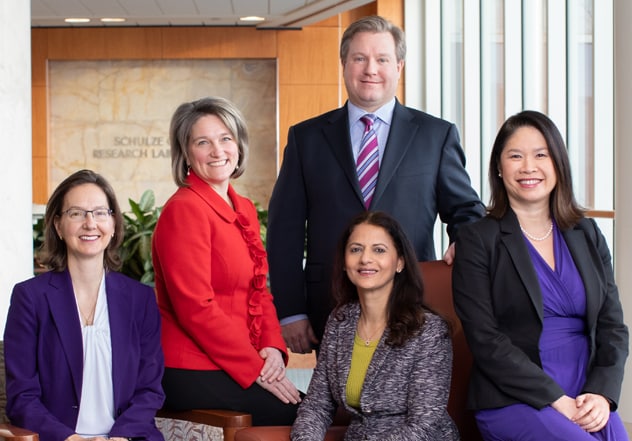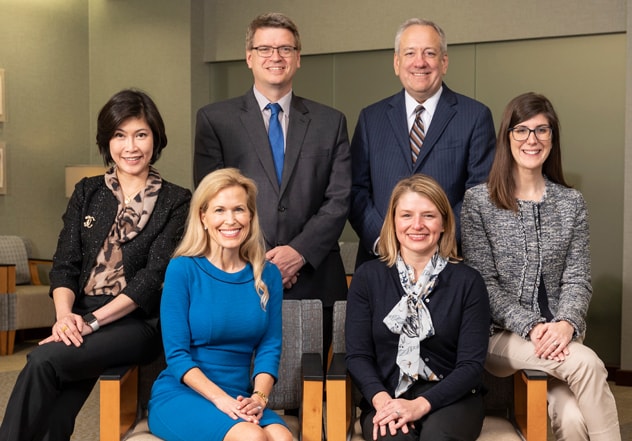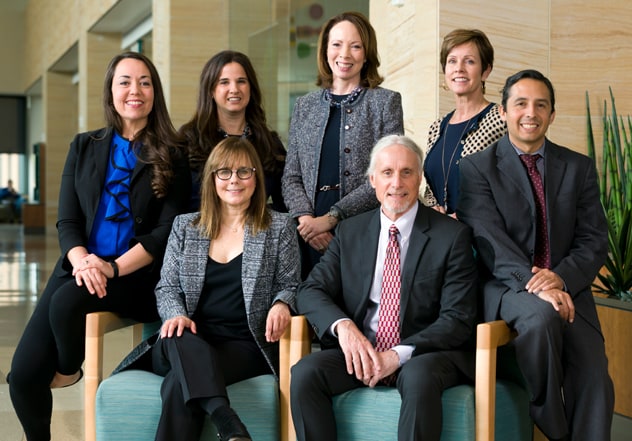Aug. 14, 2020
Personal de la Clínica de Senos del campus de Mayo Clinic en Rochester, Minnesota

Personal de la Clínica de Senos del campus de Mayo Clinic en Rochester, Minnesota
Mayo Clinic en Minnesota (en el sentido de las agujas del reloj desde la izquierda): Amy C. Degnim, MD, Cirugía Mamaria, Endocrina, Metabólica y Gastrointestinal y profesora de Cirugía en Joe M. y Ruth Roberts; Tufia C. Haddad, MD, Oncología Médica; Robert T. Fazzio, MD, Ph.D., presidente de Intervención e Imágenes de Senos; Minh-Doan T. Nguyen, MD, Cirugía Plástica y Reconstructiva; Sandhya Pruthi, MD, Clínica mamaria. No aparecen en la foto: Christina A. Dilaveri, MD, Clínica mamaria; Sarah A. Kroc, MS, CGC, Genómica Clínica; Robert W. Mutter, MD, Oncología radioterápica.
El personal del Centro Jacoby para Salud Mamaria en la sede de Mayo Clinic en Jacksonville, Florida

El personal del Centro Jacoby para Salud Mamaria en la sede de Mayo Clinic en Jacksonville, Florida
Mayo Clinic en Florida (en el sentido de las agujas del reloj desde la izquierda): Saranya Chumsri, M.D., Hematología y Oncología Médica; Brian D. Rinker, M.D., presidente, Cirugía Plástica; Robert W. Maxwell, M.D., Imágenes de Mamas; Lauren F. Cornell, M.D., Medicina Interna General; Sarah A. McLaughlin, M.D., presidente, Cirugía General; Dawn M. Mussallem, D.O., Medicina Interna General. No aparece en la foto: Laura A. Vallow, M.D., Oncología Radioterápica.
El personal de la Clínica de Senos en el campus de Mayo Clinic en Phoenix y Scottsdale, Arizona

El personal de la Clínica de Senos en el campus de Mayo Clinic en Phoenix y Scottsdale, Arizona
Mayo Clinic en Arizona (en el sentido de las agujas del reloj desde la izquierda): Juliana (Jewel) M. Kling, M.D, M.P.H., Centro de Salud de la Mujer; Brenda J. Ernst, M.D., Hematología y Oncología Médica; Michele Y. Halyard, M.D., Oncología Radioterápica y vicedecana de Suzanne Hanson Poole, Facultad de Medicina Alix de Mayo Clinic; Heidi A. Apsey, APRN, NP-C, M.S.N., Clínica de Senos; Carlos E. Vargas, M.D., Oncología Radioterápica; Donald W. Northfelt, M.D., Hematología y Oncología Médica; Barbara A. Pockaj, M.D., Oncología Quirúrgica y Cirugía Endocrina y profesor en Michael M. Eisenberg. No aparece en la foto: Alanna M. Rebecca, doctora en medicina, presidenta de Cirugía Plástica y Reconstructiva.
Breast cancer is a spectrum of disease, ranging from ductal carcinoma in situ to high-grade invasive tumors. Some tumors have strong estrogen receptors on the outside of their cells; others have HER2 receptors. Treatment depends on tumor type, size, stage, location and grade, and can be targeted to specific tumor types.
As a result, breast cancer care is more complicated than it used to be. Patients no longer see only their primary care provider for a diagnosis and referral to a surgeon for treatment. Instead, treatment today involves a multidisciplinary approach that can include medical oncology, radiation oncology, radiology, pathology, genetic counseling, breast surgery, plastic and reconstructive surgery, and survivorship. Greater complexity requires fine-tuned integration of multiple specialties to provide patients with the expert care, seamless coordination and patient experience for which Mayo Clinic is known.
Patients with a breast cancer diagnosis start in the multidisciplinary Breast Clinic. Before the initial appointment, a Breast Clinic navigator sends a series of two- to three-minute videos via the online patient portal. The videos feature Mayo Clinic physicians and patients and provide education about the breast cancer treatment journey. Patients report loving the videos and feeling more informed about the decisions they need to make. All patients first see an internist in the Breast Clinic for a comprehensive evaluation. The internist provides a warm handoff to colleagues in related disciplines and collaborates with Breast Clinic navigators and nurses to ensure that appointments are well coordinated and that patients understand next steps. After patients see all of the specialists, internists provide them with a treatment plan.
Sandhya Pruthi, M.D., General Internal Medicine, at Mayo Clinic in Rochester, Minnesota, led the Breast Clinic from 2002 to 2008. She is also president of the National Consortium of Breast Centers, which develops, maintains, advances and improves high-quality, patient-focused breast centers via education, certification and interdisciplinary communication.
"Because Mayo Clinic offers the entire range of specialists in one location, we increasingly see patients with more complex breast cancer diagnoses," says Dr. Pruthi. "We understand that a breast cancer diagnosis causes high anxiety, and we strive to be proactive in alleviating patients' concerns and the burden of navigating their care. We're here to make a positive difference in the lives of our patients during the time when they feel most vulnerable. Our goal is to help restore patients to wholeness."
The Breast Clinic also manages high-risk patients, such as those with familial breast cancer. "We're at the cutting-edge of integrated high-risk care — offering genetic testing, preventing breast cancer and reducing risk, surveilling with the latest technology, and offering preventive medication and surgical options," says Dr. Pruthi.
Minh-Doan T. Nguyen, M.D., Ph.D., Plastic and Reconstructive Surgery, at Mayo Clinic's Minnesota campus, says patients experience true collegiality from initial appointment through surgery and survivorship care.
"I repeatedly hear from breast cancer patients who are amazed at how things work at Mayo Clinic to make it so seamless and easy for them. I've been at a handful of other institutions and haven't seen a model like our Breast Clinic — internists who are the touchpoint to coordinate patients' care."
Dr. Nguyen was recruited to Mayo Clinic from the University of Cincinnati to perform autologous breast reconstruction. "I enjoy the creativity involved in breast reconstruction," she says. "Every woman's breasts look different — it's not cookie-cutter surgery. We try to give patients the results they want, whether that's restoring them to how they were or to something aesthetically better."
Tina J. Hieken, M.D., Breast, Endocrine, Metabolic, and Gastrointestinal Surgery, at Mayo Clinic in Rochester, Minnesota, is an expert in less invasive nipple-sparing mastectomy that leaves the surface of the breast intact. This procedure has become a safe option for more patients, including those whose cancer has spread to nearby lymph nodes. Surgeons remove breast tissue, leaving the skin, nipple and areola, and immediately rebuild the breast. Mayo Clinic researchers evaluated nipple-sparing mastectomy outcomes in women who had the procedure between 2009 and 2017 and presented at the 2019 American Society of Breast Surgeons Annual Meeting in Dallas. Complications within 30 days after surgery declined from 14.8% to 6.3%.
An underpinning of Mayo's breast surgical practice in Minnesota is the frozen section practice. Dr. Nguyen says that many institutions have frozen section practices for mastectomy and lumpectomy, but none are on the scale or skill level of Mayo's. For lumpectomy alone, this method of pathologic evaluation is so effective that only 3% of patients require a second surgery to track down missed cancer cells. That compares with a national rate ranging from 15% to 40%. The frozen section practice facilitates same-operation reconstructive surgery for many patients. Options include nipple-sparing mastectomy with immediate reconstruction with either implants or autologous tissue.
"Offering enhanced aesthetics as a result of these surgeries to women who have had a devastating diagnosis is extremely rewarding," says Dr. Hieken, senior author of the study. "Patients who are not offered nipple-sparing procedures should ask their surgeons why. Our study shows these surgeries are proving safe for many patients."
Highlights of breast cancer care at Mayo Clinic
- Proton beam therapy to protect the heart and lungs in left-sided breast cancer
- Nipple-sparing reconstruction
- Autologous reconstruction
- Frozen section laboratory
- Multidisciplinary consultation for patients with complex cancers
- Precision medicine tailored to a patient's genetic makeup or to the genes in the tumor
- Care for patients at high risk
- Clinical trials
- Survivorship program to help shift from illness orientation to wellness-focused care
For more information
This article originally appeared in Mayo Clinic Alumni magazine, Issue 1, 2020. It is shared here with permission.